Surviving Mars for Xbox and PC ultimate beginner's guide: Tips, tricks, and more
Surviving Mars is here and it's awesome, however, it can be a little complex. Here's what you need to know to get started.
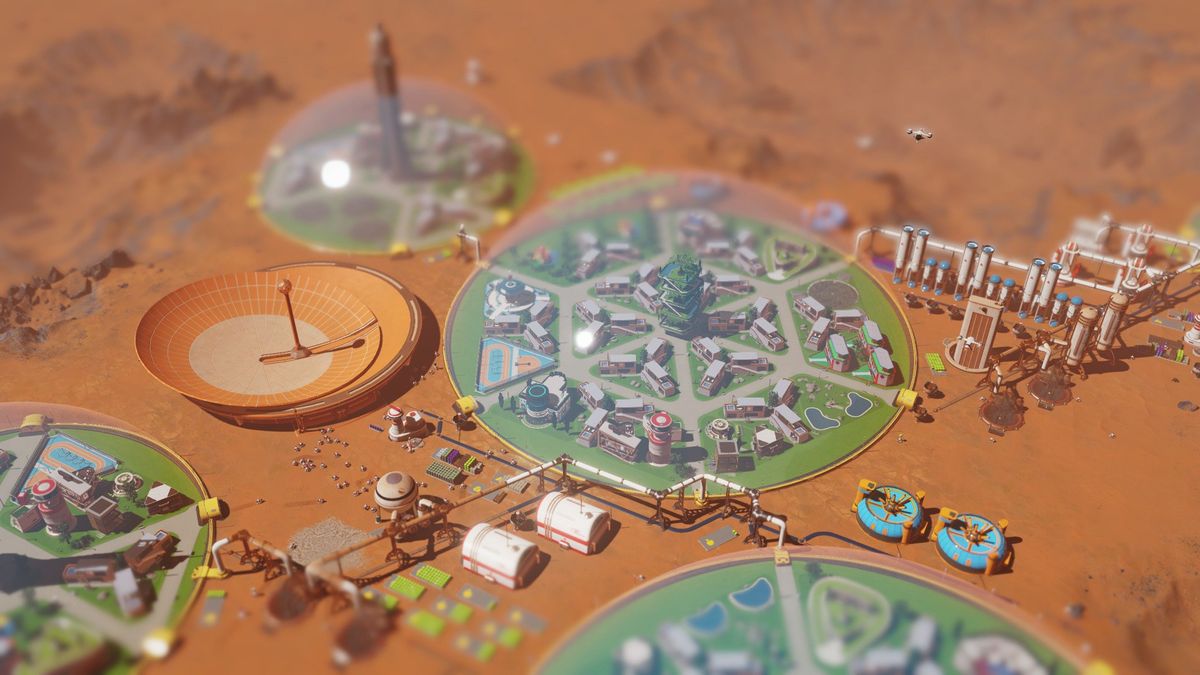
Surviving Mars is an amazing survival simulation game from Haemimont Games, known for the Tropico series. As its name suggests, Surviving Mars is all about surviving, on Mars. You and a few billion dollars are all that stands between your handful of colonists and domination of the red planet.
Surviving Mars at its core is a management game, where your main aim is the efficient use of resources available to you. You'll have to manage all types of materials, deposits, colonist's needs, oxygen, food, water, maintenance, research, and various other systems that will demand near-constant attention (depending on the difficulty you choose).
While this guide won't go over everything you need to know (since discovery in Surviving Mars is half of the fun), these tips and pointers will help you establish a colony on Mars and avoid wiping out your brave colonists.
More: Full Surviving Mars review
- Initial Planet Scan
- Landing your rocket
- First building steps
- Preparing your first dome
- Prepare to colonize
- Materials
- Colonizing Mars
- Moving on and expanding
Early days
The best thing to do to start Surviving Mars is to select the "Easy Start" menu option on the main screen. This will skip the process of choosing sponsors and specializations, and instead give you some of the easier terrain and perks to deal with. When you've learned the basics, you can go back and select "New Game," and choose more advanced perks, more difficult/interesting terrain, and add other modifiers to make for a more challenging survival experience.
The game offers hints on controls and features at the top, and you can familiarize yourself further in the game's main menu. Do this before going further, and remember to look up the controls at any time if you get confused about how to select things.

Initial planet scan
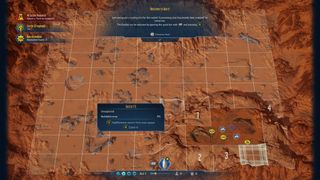
When you first load up the game, you'll be greeted with a large procedurally generated map covered in a grid. There's no real time limit when it comes to scanning here, although without building sensors on the ground, it will take a ridiculous amount of time to manually scan the whole planet. Your best bet is to simply use the instant-scan Orbital Probes the game gives you to do a quick sweep.
Get the Windows Central Newsletter
All the latest news, reviews, and guides for Windows and Xbox diehards.
Ideally, you'll want to land somewhere with concrete and water to get you going. There are surface deposits of metals that can be obtained by your rover and drone helpers, and later on you'll be able to dig below the surface – more on that later. Of course, if you're not happy with the terrain or start, you can just exit and hit Easy Start again until you're happy.
Once you find a decent landing spot, you can select the grid you want to land on, then select a target for the rocket to land. The initial cargo drop will give you a handful of rovers and drones (if you're playing on Easy Start, otherwise you choose your own starting gear). Colonists will come once you've set up a viable base camp with your robot pals.
Landing the rocket
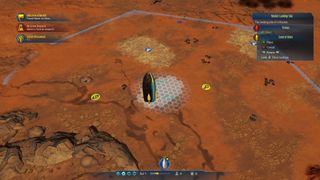
The blue radius around the rocket denotes the signal range of the rocket's command AI. The drones will be tethered to the rocket, and will only perform actions within that blue range. Ideally, you'll want to get as many resources as possible within the range of that rocket, most notably concrete and metals to begin with. Surface metals are these shiny metallic rocks you can see above, the red icon is an underground mine that requires an extractor and colonists to tap into.
First steps
On Easy Start mode, you'll get a bunch of robots to help you get going. Your drones are completely autonomous, and will move materials around to build designated projects, repair existing buildings, and other vehicles. Robots require power, and your first point of call should be setting up an electricity grid. Initially, the robots will be able to recharge via the rocket, which on Easy Start mode self-refuels thanks to the rocket scientist perk. Once it is done refuelling it can be sent back off into space so you can call on it later for further resources, which is why you shouldn't rely on it for longer than necessary.
Drones need their own Drone Hub to issue commands, and a suitable electrical grid to keep it powered. Additionally, you'll need to set up some depots to offload the materials from the rocket so you can send it away. You'll also want to begin setting up research to help establish futuristic tech to help with the colonization effort. That might seem like a lot to take in at first, so here's an easy step-by-step run through.
- Set up depots in the storages list from the build menu. This will automatically cause your drones to offload the rocket, and also extract any other nearby metals automatically into a central place.
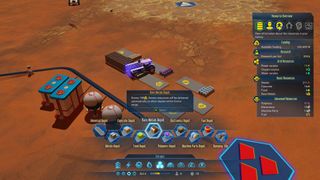
- Build an early electrical grid, composed of either solar panels, Stirling generators, wind turbines, or a combination. You can use power accumulators to store surplus power in batteries. Read the tooltips of the different power generators to investigate their weaknesses and benefits.
- Build a Drone Hub, positioning its radius over as many nearby resources as possible so that your drones can reach all of your future buildings to perform maintenance and move goods around. Note that your larger rovers do not require a Drone Hub to operate, but do need to be manually connected to the grid to recharge at times, so keep an eye on their batteries.
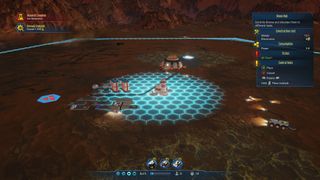
- Go to the Research menu (left trigger on Xbox, "O" on PC) and begin queuing up research options. Research will help you discover new technology to empower your colony, eventually leading to complete self sufficiency. It might also be worth outsourcing some research by spending money to speed up the process early on, since you won't have your own scientists for a little while. There's some more notes on research further along in this guide.

Preparing for your first dome
Next, you'll want to start preparing for your first habitat dome, setting up material extractors, oxygen generators, and water sources. Concrete is the essential building block for all of your major constructions, you'll need tons of it. Oxygen and water are also essential, for obvious reasons. Here are some steps for getting set up.
Before we begin, though, do plan ahead. You'll need a large space for the dome (you can select it in the build menu to see), and it's ideal to build your dome away from extractors and rocket landing sites. It will take maintenance damage from nearby extractors, which produce thick clouds of mining dust.
- Set up a Concrete Extractor on a concrete deposit from the "Production" list in the build menu. Position the extractor so that the deposit number is as high as possible in the tooltip on the top left, then build it, ensuring it's far away from other buildings as possible (due to the dust it will create). It will need to be connected to your electrical grid, within range of your Drone Hub, a concrete depot, and a waste rock depot (or three).

- Set up a water source. If like me, you've landed in a place without an underground water source, you'll need to use a Moisture Vaporator, connected to pipes and electrical cables. Otherwise you can use a Water Extractor, which will also need to be within range of your Drone Hub, power, and a waste rock depot. Multiple vaporators need to be spaced out from each other (denoted by a blue radius), because otherwise they won't have enough moisture to, well, vaporate.
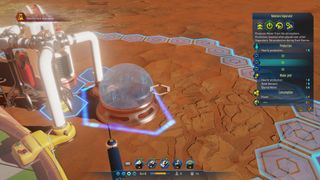
- Set up an oxygen source. You can use the same pipes as your water source (although more advanced players like to separate grids, and even create pipe redundancies in case of pipe failures).
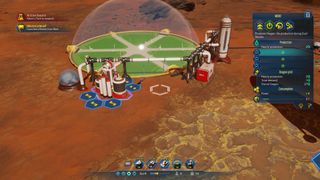
- It's worth setting up water and air storage tanks in case of meteor strikes or other disasters. It's ideal to space these out, too, so they don't all get hit by the same disaster for example.
- Build your dome! The dome requires a ton of polymers, concrete, and metal to build, and your drones will begin moving the resources around as necessary.

Preparing for colonization
At this point you'll want to take stock of everything you've done so far as you prepare to invite your first colonists. Here are some tips on what you should monitor before calling in your first passenger rocket.
Research priorities

Check your research situation. You should always have something researching, because you're effectively racing against the clock to the point of self-sufficiency. If you don't research more powerful tech fast enough, you could bleed your local resources dry and end up at a dead end.
Most trees offer powerful and needed options, but I find the robotics and physics trees to be the most important, as they can help you find resources more easily, and crucially, access them without colonists and domes, via automation. The research tree is randomized for each play-through, so there's no ideal path forward. You can see how much research you need per sol (per day) to research an item. The lower level stuff is relatively fast, and on Easy Play mode, can be burned through pretty quick via outsourcing.
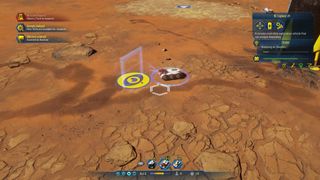
Select your RC Explorer rover to scan yellow circles on the map. These grant large research bonuses, occasionally bringing powerful breakthrough tech, and early access to late-stage research. Just don't forget to keep its batteries charged!
Check that you have enough life support

The dome and its interior buildings will use up additional power and resources, so make sure that you have a surplus of electricity going in. The last thing you need is an underpowered dome, with freezing, starving colonists.
You can check the current status of your colony via the Colony Overview menu (left trigger on Xbox, bottom left of the HUD on PC). This shows your current situation for materials, grid resources, research speed, and funding.
Use your RC Transport to comb the area for metal
The RC Transport to scrape metal deposits that are further away from your Drone Hub, since it doesn't need the connection.
- Select the RC Transport, then select "Create Transport Route."

- Find a surface metal deposit. They look like black shiny rock clusters scattered around. Sometimes they can be rare, sometimes they appear in abundance.
- Select the metal deposit, then move the camera back and select your metal depot.
- The RC Transport will ride back and forth collecting the metal, and placing it in your depot. Note: If you put a cable near your depot, it'll also recharge its batteries automatically on every return trip.

Materials
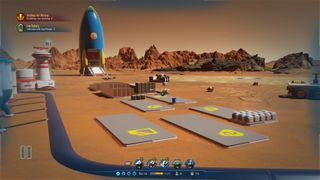
Since you should now have enough concrete and metals to build basic structures, you might need to begin resupplying your manufactured materials like polymers, electronics, and machine parts.
For reference, the bulk of your advanced materials will be used to create and repair buildings.
- Concrete is mostly used in less complex buildings.
- Metals are often used to repair essential buildings like solar panels, vaporators, and oxygen generators.
- Polymers are used to build some advanced structures, like power accumulator batteries, and also repair and maintain them.
- Electronics are used to repair rovers and other advanced buildings, like the Drone Hub. Electronics are manufactured in special factories using rare metals, and I've found them to be the hardest to acquire in most of my colonies. Try to limit the reliance on electronics as much as possible.
- Machine Parts are used to repair mechanical structures, like wind turbines and extractors. They're easier to obtain than electronics, as they can be manufactured from regular metal, but early on it can be a pain to acquire them. Restrict your reliance on wind turbines to lower the need for them early on.
In the early days of your colony, you'll do this quite a bit, using your colonization funds from your sponsor. You can get more funds by exporting rare metals using a rare metal extractor (once you have an established colony) or by researching special tech like Mars Patents, usually found under the social tree.
- Select the "Resupply" menu option from the menu.
- Select "Cargo Rocket."
- Here, you can spend money to get resources you can't easily obtain until the later stages of play, like Machine Parts, Electronics, and Polymers. I save almost all of my cash for these materials early on, but you can also buy pre-made Prefab Buildings too, such as Moisture Vaporators, if you haven't yet researched how to build them yourself.

You're now pretty much ready to set up your dome and call in your first colonists.
Colonizing Mars
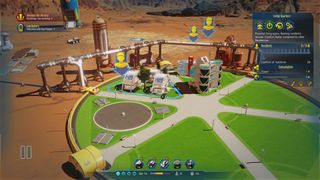
The next step in the road is to actually colonize Mars. You should start by setting up some buildings inside your shiny new dome to accommodate colonists. You can find all of these options under the build menu. Just make sure you land the rocket near the dome, but not too close as to damage the dome. Your colonists can only walk so far.
- Set up some accommodation. Living quarters are the lowest-tier housing solution. Later on, new ones will open up that offer more space and improved comfort.
- Set up some places of work. Ideally you want farms to get food, and research buildings to speed up your technological advancement. It's also worth building an infirmary to treat colonist's illnesses and stress. You might also want to add a diner or a grocer so that colonists can get prepared food. Raw food from the farms will impact their comfort level.
- If your dome is near an underground metal deposit, you could also build a metal extractor, but it needs to be within walking distance of your dome.
- Once you've set up your basic buildings, call in a passenger rocket from the menu.
Choosing colonists
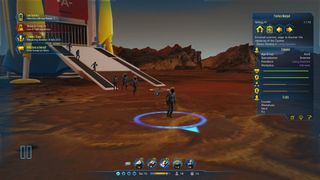
The next step is crucial for making an efficient colony. Selecting the ideal candidates can make or break your early colony, particularly on harder difficulties. Colonists are broken down by age, traits, flaws, and specialization. You can filter these on the passenger candidate screen, and then select passengers manually before launching your rocket. Here are a few tips for choosing good colonists.
- Regarding age, if you pick senior citizens, their work life will be limited until you research gene therapy later on. It's ideal to select youths or adults.

- There are seven job roles, botanists more effectively tend to farms, scientists more effectively generate research, medics are more effective in the infirmary, geologists are more effective in your metal extractors, and engineers are more effective in factories that build more advanced materials. You should also note security personnel, who can protect a colony from rogue colonists (although I've never experienced a situation where they were needed), and "No specialization" colonists, who are good for basic roles, such as service buildings and shops. Each main job role comes with certain interests which must be serviced using certain building types. You can select each of the job roles for more information.

- Select your buildings to see what types of roles fit best, and aim to fill work place slots as effectively as possible. While a scientist can work on a farm, they'll take penalties for doing so. So try to match passengers to available work slots, until you can later train your own colonists using a Martian university.
- Pay attention to traits and flaws. Sometimes selecting workers with negative flaws, such as "lazy" is impossible to avoid if you need a specific role due to the limited amount of applicants at any given time. Later on you'll be able to build a Sanitorium to treat flaws.
Colonists will automatically seek ideal job roles that are available, paying attention to the priority level you've set to your buildings. Early on I tend to prioritize scientists to maximize research speed, which will help you massively later on.
Moving on and expanding

We've covered the basics of setting up a colony. Here are some final tips for moving forward, expanding, and sustaining your colony in the long term.
- You can craft tunnels to expand your base to areas below cliffs if you've ended up on top of an elevated area.
- You can use the RC rover to take drones to remote locations to set up secondary bases.
- You can use a Shuttle hub to create automated aerial drones who will transport materials between depots as needed. The "Universal depot" is useful for setting up remote bases that might not need a full complement of materials, but still need a place for a shuttle drone to land. Shuttles can also ferry colonists from overpopulated domes to underpopulated ones.
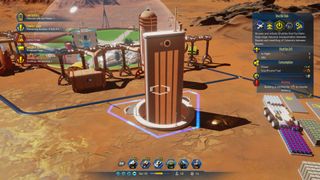
- You should start looking into manufacturing advanced materials, such as Fuel refineries for rockets, Polymer factories, Machine part factories, and Electronics factories. Some of these become unlocked with research, but can be purchased pre-made via cargo rocket.
- Pay attention to your colonist's needs. Some of them will want specific types of facilities in order to maintain sanity and happiness, you can monitor this in the Colony overview screen via the menu. A happy dome will begin breeding too, granting additional workers, and the means to expand.
- Explore your surroundings and buildings. Some buildings can be upgraded and configured, such as farms, and simply panning around the map you might find additional surface metals for gathering.
- Later, you will be able to deep scan for extremely rich metal deposits, and later still, craft a gigantic extractor that will provide limitless resources.
- This guide only covers the basics, there are tons more research options to discover, mysteries to unravel, and other features that will reveal themselves as you play!
That's a wrap!
Hopefully these pointers will get you started on your mission to colonize Mars. If you have any further questions, drop them in the comments below!
Surviving Mars is available now for Xbox One, PS4, and PC for $39.99.

Jez Corden is the Executive Editor at Windows Central, focusing primarily on all things Xbox and gaming. Jez is known for breaking exclusive news and analysis as relates to the Microsoft ecosystem while being powered by tea. Follow on Twitter (X) and Threads, and listen to his XB2 Podcast, all about, you guessed it, Xbox!